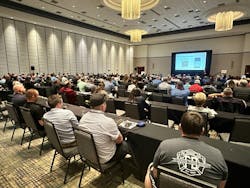Eight Station Design Conference Takeaways
Last month, the 10th annual Station Design Conference was sold out with more than 750 attendees. Over four days, fire, law enforcement (LE), and municipal leaders heard from more than 60 speakers on designing, project management, and trends in public safety facilities.
Conference programs focused on topics for designing and building fire stations, LE and public safety facilities. At the end of each program, the speaker offered a summation or a “takeaway” message. We wanted to share several “takeaway” messages from the presentations.
Overcoming Current Economic and Supply Chain Issues During Your Station Project
Ken Newell, Stewart-Cooper-Newell Architects
Recently, projects have experienced severe delays with supply chain problems and the worst construction climates in U.S. history.
Takeaway: “Construction prices are higher than ever and some of the post-pandemic supply chain delays remain. With proper pre-planning, you can implement tools to ensure the best prices available, and with the right project delivery methods the builder can order long lead items early enough to lessen the impact on your construction schedule.”
Blueprint for Success: Crafting a Comprehensive Station Program of Requirement
Lynn Reda, AIA, LEED AP, NCARB, Studio Principal Community, Little Diversified Architectural Consulting
One of the first steps in designing a new fire station or facility is to develop a comprehensive station Program of Requirement.
Takeaway: “The foundation of a successful and comprehensive program document is people, and time. Assemble a team that represents a deep cross-section of your department and the building users; engage stakeholders intentionally throughout the process. Then, allow your team enough time to thoroughly research and document what is needed both on day one of occupancy and well into the future. Careful attention to people and time will create a blueprint for success that stands up to the scrutiny of politicians and the public.”
Safety First: A Case Study in Threat Mitigation
Brett Hanson & Jeff Humphreys, MACKENZIE, and Chuck Streichen, Bureau of Investigations and Services, Lynnwood Police Department, WA
Increasing safety issues, key design strategies for law enforcement and safety awareness for public safety facilities.
Takeaway: “Safety and security is paramount to today’s law enforcement facilities, but accomplishing your objectives does not have to come at the expense of a non-welcoming building. Thoughtful design considerations coupled with crime prevention through environmental design strategies can passively reduce crime and threats in and around your building while reinforcing the effectiveness of your physical security infrastructure.”
Health and Wellness by Design
Christopher Kehde, FGM Architects and John Jeniec, Fairfax Fire Department
Incorporation of design strategies and concepts to reduce contaminant exposure and promote physical and mental wellness focused on protecting those who serve and protect communities.
Takeaway: “Health and Wellness by Design describes an approach to designing fire and rescue stations that recognizes the unique health risks associated with the fire service and responds by incorporating specialized measures such as Hot Zone Design, Sleep Hygiene, Biophilic and Immersive Design, and Holistic Resilience to support firefighter mental, physical, and behavioral health.”
A Public Safety Facilities Roadshow: Intrinsic Value, Challenges and Fascinating Facts
Brian Harris, TCA Architecture + Planning + Design & Brian Berryhill, Roth Sheppard Architects
Multiple departments in one location can add competing or conflicting interests, integrated facilities offer solutions from a cost, collaboration, and one-stop shop perspective.
Takeaway: “Understand the historical issues in other facilities across the country, i.e. funding issues, stakeholder growth patterns, changing technological demands, independent security needs, facility maintenance obligations, cultural differences between partners, etc. and map out possible solutions upfront.”
Designing a Fire Station in a Historically Sensitive Location
Todd M. Sweet & Karl Bernhard, Sweet Sparkman Architecture & Interiors
Three new fire station projects posed unique challenges in Florida’s historic districts.
Takeaway: “Really get to understand as much about the community you are designing for. Understand the project costs, plan for escalation and realistic construction cost, historic detailing and nuances with designing in historic districts will be more expensive.”
Fighting City Hall: The Battle to Gain Local Government Approval to Relocate a Fire Station
Chief Paul Segalla & Andrew Wienckowski, Long Grove, IL, Fire Protection District, and Andy Jasek, FGM Architects
One fire district, which covers seven municipalities, navigates numerous processes to move a single fire station to a new location.
Takeaway: “Have alternatives ready at each step of the planning and zoning process and be prepared for the unexpected. Even though fire stations are for public safety, it doesn’t mean the public is in favor of them.”
(Note: Segalla advised last week that they received approval to acquire the property and entered the design phase.)
Final thoughts
Each speaker offered takeaways from their presentations, but it was a popular conference presenter, Dennis Ross, H2M architects + engineers, who summed up the process of designing a new fire or public safety facility:
“Don’t waver, don’t wimp out, keep your eyes on the prize. Remember, public support for your project is always a good omen, for numerous reasons, funding being the most important.”
After 17 years of organizing fire station design conferences, I offer my own Takeaway: Start your research when you first start talking about a new station. The sooner you start, the fewer errors and the more time and money saved.
JUST ANNOUNCED: The 2025 Station Design Conference will be held May 19–22, 2025, once again at The Renaissance Hotel in Glendale, AZ.
About the Author
Janet A. Wilmoth
Special Projects Director
Janet Wilmoth grew up in a family of firefighters in a suburb of Chicago. Wilmoth, who is owner of Wilmoth Associates, worked with Fire Chief magazine for 27 years until it closed in 2013. She currently is the project director for Firehouse, overseeing the Station Design Conference.

